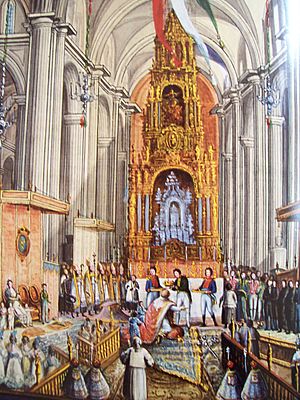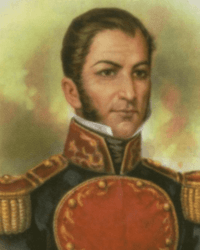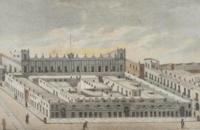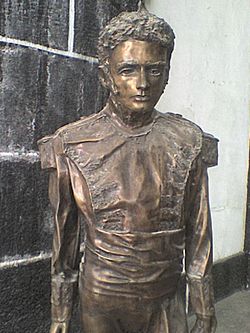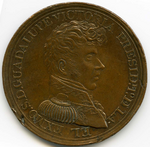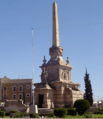Guadalupe Victoria facts for kids
Quick facts for kids
The Most Excellent
Guadalupe Victoria
|
|
|---|---|

Portrait of Guadalupe Victoria by Carlos Paris
|
|
| 1st President of Mexico | |
| In office 10 October 1824 – 31 March 1829 |
|
| Vice President | Nicolás Bravo |
| Preceded by | Office established |
| Succeeded by | Vicente Guerrero |
| President of the Supreme Executive Power | |
| In office 1 July 1824 – 31 July 1824 |
|
| Preceded by | Vicente Guerrero |
| Succeeded by | Nicolás Bravo |
| Member of the Supreme Executive Power | |
| In office 30 July 1834 – 10 October 1835 Serving with Miguel Domínguez
Vicente Guerrero Nicolás Bravo Mariano Michelena Pedro Celestino Negrete |
|
| Governor of Puebla | |
| In office 31 March 1834 – 13 December 1836 |
|
| Preceded by | Patricio Furlong |
| Succeeded by | Cosme Furlong |
| Personal details | |
| Born |
José Miguel Ramón Adaucto Fernández y Félix
29 September 1786 Tamazula, Nueva Vizcaya, Viceroyalty of New Spain (now Durango, Mexico) |
| Died | 21 March 1843 (aged 56) San Carlos Fortress, Perote, Veracruz, Mexico |
| Resting place | Column of Independence |
| Nationality | |
| Political party | Independent party |
| Spouse |
María Antonia Bretón
(m. 1817) |
| Relatives | Francisco Victoria (brother) |
| Alma mater | San Ildefonso College |
| Occupation | Lawyer Soldier (General) |
| Signature |  |
Guadalupe Victoria (born José Miguel Ramón Adaucto Fernández y Félix; 29 September 1786 – 21 March 1843) was a brave Mexican general and political leader. He fought for Mexico's freedom from the Spanish Empire during the Mexican War of Independence. He later became the very first president of the United Mexican States.
As president, he made friends with countries like the United Kingdom and the United States. He also started the National Museum and helped improve education. He made sure the border with the United States was clear. He also ordered the Spanish people who still supported Spain to leave the country. He even defeated the last Spanish stronghold in Mexico at the San Juan de Ulúa castle.
Guadalupe Victoria was the only president in Mexico's first 30 years of independence to finish his full term. He passed away in 1843 at age 56 from epilepsy. His name was later written in golden letters in the hall of the Chamber of Deputies to honor him.
Contents
Early Life and Learning
Guadalupe Victoria was born on 29 September 1786. His birth name was José Miguel Ramón Adaucto Fernández y Félix. He was born in Tamazula, which is now in the state of Durango, Mexico. His parents, Manuel Fernández and Alejandra Félix, died when he was young. He was raised by his uncle, Agustín Fernández, who was a priest.
He studied at the Seminary of Durango. To pay for his food, he copied Latin grammar books and sold them. In 1807, he moved to Mexico City. There, he studied law at the San Ildefonso College. He graduated as a lawyer in 1811.
Fighting for Independence
In 1812, Guadalupe Victoria joined the rebel forces fighting for Mexico's independence. He fought alongside famous leaders like José María Morelos. He was known for his successful attacks on military convoys.
The Attack on Oaxaca
The attack on Oaxaca happened on 25 November 1812. The rebel forces, led by José María Morelos, won against the Spanish army. Many important rebel leaders, including Guadalupe Victoria, were part of this battle.
During the fight, Guadalupe Victoria showed great courage. He saw a moat that his soldiers were afraid to cross. He threw his sword over the moat and shouted, "There goes my sword as pledge, I'm going for it!" He then swam across the moat. He cut the rope of a bridge, which allowed the rebel troops to enter the city.
Winning Oaxaca was a big deal for the rebels. It made Morelos a very respected military leader. It also gave them control over important roads and towns. After this victory, Guadalupe Victoria was put in charge of the rebel army in Veracruz. He also changed his name to Guadalupe Victoria. He chose "Guadalupe" because of his faith in the Virgin of Guadalupe. He chose "Victoria" to mean victory.
Controlling Veracruz
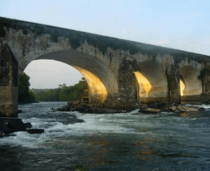
In 1815, Victoria led the rebels in the Veracruz region. He used guerrilla warfare tactics. This means he used small groups to make surprise attacks. He took control of the Puente del Rey (King's Bridge). This bridge was important because it connected Xalapa to the port of Veracruz.
He also took control of Boquilla de Piedras, a port on the Gulf of Mexico. This port helped the rebels get supplies. But in 1816, the Spanish army took it back. Victoria continued to fight hard, but by mid-1817, he had lost most of his positions.
After a defeat in Palmillas, his men left him. He was hunted by the Spanish army. He hid in the jungle for almost four years. He survived by eating plants, fruits, and animals. He refused to accept a pardon from the Spanish leader. During this time, he developed epilepsy. His rare appearances made him a legend among the local people.
The Plan of Iguala and Treaty of Córdoba
Guadalupe Victoria stayed hidden in the jungle for a long time. The fight for independence was difficult during these years. Most rebels accepted pardons from the Spanish government. Only Vicente Guerrero kept fighting.
In late 1820, the independence movement gained new energy. Victoria learned about the progress and came out of hiding on 30 December 1820. A small group of soldiers quickly joined him.
On 24 February 1821, Agustín de Iturbide and Vicente Guerrero announced the Plan of Iguala. This plan aimed to make Mexico independent. Many Spanish military leaders and former rebel leaders joined the plan, including Guadalupe Victoria. On 6 April, Victoria declared independence in the town of Soledad. By late May, most of Veracruz was fighting for independence.
The Army of the Three Guarantees was formed to fight the Spanish forces. These battles continued until 21 August 1821. On that day, Iturbide and the Spanish leader Juan O'Donojú signed the Treaty of Córdoba. This treaty recognized Mexico's independence.
On 27 September 1821, the Army of the Three Guarantees marched into Mexico City. Guadalupe Victoria was among the officers. The next day, the Declaration of Independence of the Mexican Empire was signed.
The Mexican Empire
Guadalupe Victoria met with Agustín de Iturbide in June 1821. Victoria wanted Mexico to be a republic. He suggested a specific type of ruler. Iturbide did not agree. Both men wanted independence, but they did not trust each other.
Iturbide became the leader of Mexico. On 18 May 1822, he was declared emperor. He chose all the members of the first government. Most of them were wealthy and had supported Spanish rule before. None of the former rebel leaders, like Guadalupe Victoria, were included.
In early 1822, some former rebels who wanted a republic started meeting. They talked about the future of the government. Iturbide thought this was a plot against him. Many people, including Guadalupe Victoria, were arrested. Most were released, but Victoria stayed in jail. He soon escaped and hid in Veracruz.
Congress wanted to review Victoria's case because he had been elected as a deputy. But Victoria chose to stay hidden. On 21 July 1822, Agustín de Iturbide was crowned Emperor of Mexico. However, the Emperor and the Congress did not get along. Iturbide eventually closed the Congress.
The Plan of Casa Mata
Because there was no Congress and the Emperor acted without limits, people started to plan changes. Antonio López de Santa Anna announced the Plan of Casa Mata. Soon, Vicente Guerrero and Nicolás Bravo joined him.
On 6 December 1822, Guadalupe Victoria came out of hiding to join this movement. Santa Anna knew Victoria was popular. He made Victoria the leader of the movement. Together, they announced the Plan of Veracruz.
On 1 February 1823, a big change happened. Imperial generals signed the Plan of Casa Mata. Iturbide was forced to bring back the Congress. He gave up his title as Emperor on 19 March 1823.
Leading the Country
On 26 March 1823, it was decided that Iturbide and his family had to leave Mexico. On 31 March 1823, Congress created a temporary government called the Supreme Executive Power. Guadalupe Victoria was one of its members.
Even though he was part of this new government, Victoria stayed in Veracruz. He made sure Iturbide left the country safely. He also organized defenses against Spanish attacks from the San Juan de Ulúa fortress.
The Supreme Executive Power had to guide the former provinces to form a Federal Republic. They also had to call for new elections. They faced challenges, like some Central American provinces choosing not to join Mexico. Also, some Mexican states declared themselves independent.
On 31 January 1824, the Constitutive Act of the Federation was approved. This act said that Mexico was a sovereign nation made up of free states. On 4 October 1824, the Federal Constitution of United Mexican States was announced.
President of Mexico (1824–1829)
| Government of Guadalupe Victoria | ||
|---|---|---|
| Office | Name | Term |
| Foreign and Interior Relations | Juan Guzman | 10 October 1824 – 11 January 1825 |
| Lucas Alamán | 12 January 1825 – 26 September 1825 | |
| Manuel Gómez Pedraza | 27 September 1825 – 2 November 1825 | |
| Sebastián Camacho | 3 November 1825 – 5 July 1826 | |
| José Martín Espinosa de los Monteros | 6 July 1826 – 7 March 1828 | |
| Juan de Dios Cañedo | 8 March 1828 – 25 January 1829 | |
| José María Bocanegra | 26 January 1829 – 1 April 1829 | |
| Justice and Ecclesiastical Affairs | Pablo de la Llave | 10 October 1824 – 29 November 1825 |
| Miguel Ramos Arizpe | 30 November 1825 – 7 March 1828 | |
| José Martín Espinosa de los Monteros | 8 March 1828 – 31 March 1829 | |
| Treasury | José Ignacio Esteva | 10 October 1824 – 26 September 1825 |
| Pable de la Llave | 27 September 1825 – 27 November 1825 | |
| Jose Ignacio Esteva | 28 November 1825 – 4 March 1827 | |
| Tomas Salgado | 5 March 1827 – 1 November 1827 | |
| Francisco García | 2 November 1827 – 30 November 1827 | |
| José Ignacio Pavón | 1 December 1827 – 7 March 1828 | |
| Jose Ignacio Esteva | 8 March 1828 – 12 Jan . 1829 | |
| Bernardo Gonzalez Anugulo | 13 January 1829 – 1 April 1829 | |
| War and Marine | Manuel Mier y Teran | 10 October 1824 – 18 December 1824 |
| Jose Castro | 19 December 1824 – 7 January 1825 | |
| Manuel Gómez Pedraza | 8 January 1825 – 7 June 1825 | |
| Jose Ignacio Esteva | 8 June 1825 – 14 July 1825 | |
| Manuel Gómez Pedraza | 15 July 1825 – 9 February 1825 | |
| Manuel Rincon | 10 February 1827 – 3 March 1827 | |
| Manuel Gómez Pedraza | 4 March 1827 – 3 December 1828 | |
| Jose Castro | 4 December 1828 -7 Dec 1828 | |
In August 1824, elections were held for president. Guadalupe Victoria was elected the first president of Mexico. On 2 October 1824, he was officially declared president. He took office on 10 October 1824. His full term began on 1 April 1825. On that day, he promised that Mexico's independence and freedom would be protected, even if it cost him his life.
Challenges at Home
As president, Victoria had to rebuild Mexico's economy. The long war had caused a lot of damage. To help with trade, he created Mexico's own merchant navy. This opened up trade with other countries that recognized Mexico's independence.
Money was a big problem for Victoria's government. They spent much more than they collected in taxes. To fix this, Victoria got loans from the United Kingdom. These loans helped prevent the country from going bankrupt. They also helped keep peace in society.
Despite money problems, Victoria's time as president had many good things. He set up the National Treasury. He also created the Military Academy. He improved education and gave freedom to political prisoners. He planned a canal and opened new ports. He also started building the National Museum.
Victoria also supported the Lancasterian Society, which focused on education. He built a navy. This navy helped Mexico achieve full independence. On 18 November 1825, the last Spanish stronghold, the fortress of San Juan de Ulúa, was taken.
Victoria tried to bring different groups together in politics. He chose people from different sides for his government. However, old conflicts continued. He had to balance religious tolerance with freedom of speech and press, which were in the Constitution.
On 20 December 1827, he ordered the Spanish people to leave Mexico. This was because some wealthy Spaniards had supported a plot to bring back Spanish rule. This caused economic problems because many of these Spaniards were traders who took their money with them.
Taking San Juan de Ulúa
The War of Independence had damaged Mexico's economy. The government struggled to collect taxes. It was hard to plan an attack on the Spanish fortress of San Juan de Ulúa.
But Victoria's government bought ships to create the first Mexican Navy. Finally, on 23 November 1825, the Mexican Navy captured San Juan de Ulúa. This was the last place the Spanish held in Mexico.
Northern Lands
Guadalupe Victoria refused offers from the United States to buy Texas. On 18 August 1824, a law was passed to encourage people to move to Mexico's northern lands. This law gave settlers land and tax breaks for ten years.
Many Americans moved to these areas. They kept their own language, religion, and customs. This meant they did not connect well with the rest of Mexico. They also ignored Mexican laws and continued slavery. In 1826, there was an attempt to separate from Mexico. A man named Haden Edwards tried to create the Republic of Fredonia in Texas. This rebellion was quickly stopped.
Because of this, Victoria sent General Manuel de Mier y Terán to inspect the Texas settlements. His reports led to new laws in 1830. These laws made it much harder for Americans to move into Texas.
Nicolás Bravo's Uprising
During his time as president, Guadalupe Victoria faced several attempts to overthrow his government. One was discovered in late 1827.
On 23 December 1827, a group called the Scottish Lodge announced the Plan of Montaño. This plan had four main points:
- End secret societies.
- Change the government.
- Expel the U.S. ambassador, Joel R. Poinsett.
- Follow the Constitution strictly.
Vice-president Nicolás Bravo led this uprising. He said he only wanted to free the government from the influence of another group. The plan also wanted to reorganize the government and remove the U.S. ambassador. (Joel R. Poinsett was indeed expelled from Mexico in 1830).
Vicente Guerrero stopped the uprising on 6 January 1828. Nicolás Bravo was sent out of the country.
The Mutiny of La Acordada
The Mutiny of La Acordada happened on 30 November 1828. It was a revolt against Guadalupe Victoria's government. This happened when people learned that Victoria supported Manuel Gómez Pedraza for president.
In the 1828 elections, Manuel Gómez Pedraza won. But Vicente Guerrero did not accept the results. He started a revolution. The rebels demanded that President Victoria resign and be replaced by Guerrero. Gómez Pedraza fled Mexico City.
A mob then looted and burned shops in El Parian, a big market. This ruined many traders. As a result, in early 1829, Congress canceled the 1828 election. They chose Vicente Guerrero as president instead. Victoria handed over the presidency to Guerrero when his term ended on 1 April 1829.
International Relations
One of Victoria's main goals was for other countries to recognize Mexico as independent. He achieved this by setting up diplomatic relations with the United Kingdom, the United States, the Federal Republic of Central America, and Gran Colombia. This helped reduce the economic problems caused by Spain's trade restrictions. British companies also started mining in Mexico, bringing in more money.
He also confirmed the border with the United States. Victoria stated that Mexico would not talk to Spain until Spain recognized Mexico's independence.
Another important achievement was his support for the Pan American Union. This idea was proposed by Simón Bolívar. It led to a treaty between Colombia, Central America, Peru, and Mexico. Victoria also sent money to Simón Bolívar to help Peru gain full independence from Spain.
Later Years and Legacy
After his presidency, Victoria retired to his farm in Veracruz. In 1832, the government asked him to help calm down Antonio López de Santa Anna, who was causing trouble. A year later, in 1833, Victoria was elected senator for Veracruz and Durango. He also fought against rebellions in Veracruz and Oaxaca.
His health began to get worse, and he had more epileptic seizures. This prevented him from finishing his term as governor of Puebla. He returned to the Senate and was elected president of the Senate in 1835. He strongly opposed a plan to change Mexico from a federal republic to a centralized one.
In 1838, Victoria played a key role in avoiding a war with France. This event is known as the Pastry War. On 9 March 1839, he successfully signed a peace treaty with France. This was his last public act.
Death and Honors
In 1841, he married María Antonieta Bretón y Velázquez. His health continued to decline due to his epilepsy. He moved to the Castle of Perote for medical care. He died there on 21 March 1843 and was buried there.
On 25 August 1843, Congress declared Victoria a "Worthy of the Nation." His name was written in golden letters in the hall of the Chamber of Deputies. In 1863, his remains were moved to the Column of Independence in Mexico City.
On 15 August 2010, his remains were moved to the National Palace for a special display. This was part of the celebration of Mexico's 200 years of independence. On 20 July 2011, his remains were returned to the Column of Independence.
Guadalupe Victoria is seen as a national hero in Mexico. Many places are named after him, including:
- Ciudad Victoria, the capital of Tamaulipas.
- Victoria de Durango, the capital of Durango.
- Tamazula de Victoria and Ciudad Guadalupe Victoria in Durango.
- Guadalupe Victoria in Puebla.
- Victoria City and Victoria County in the United States.
- The frigate ARM Victoria (F-213).
- General Guadalupe Victoria International Airport.
Coins, Stamps, and Monuments
- A bust of Guadalupe Victoria was given to the City of Los Angeles in 1997. It is in Lincoln Park.
Images for kids
See also
 In Spanish: Guadalupe Victoria para niños
In Spanish: Guadalupe Victoria para niños



